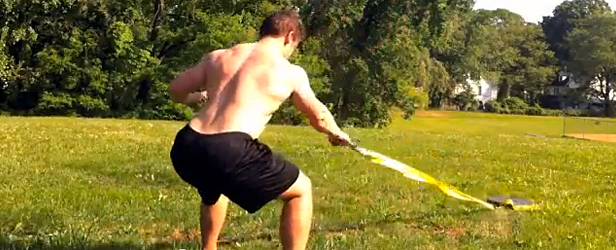
Dragging a sled is one of the best things that you can do for yourself as an athlete. It combines the total body stimulus and connectedness of a loaded carry with the specificity of multi-joint lifts usually done in a weight room.
Relative to other training tools, sleds are dirt cheap (most lifters spend about the cost of a sled on supplements each month). They're portable and have almost zero learning curve. They're also one of the safest tools around because they're self-limiting. You're fighting friction, not gravity. Last, but not least, training with a sled is highly transferable to your field of play whatever that may be—the football field, powerlifting platform, or MMA ring.
There isn't any excuse for not using sleds, especially now with the introduction of the Spud, Inc. Magic Carpet Sled. I’ve been using it for a week and I’m hooked. It’s brilliant on grass, turf, rubber, and wood studio floors. If you’re a trainer, coach, and/or strength junkie, buy one. In my opinion, there isn't anything else that fits in your gym bag that will give you a better bang for your buck.
Try these eight sled drag variations:
This is a unique pressing position. It's great for athletes in contact sports and helps teach beginners how the hips stabilize a good press. It teaches synchronicity and coordination between the hips and shoulders because the athlete must “reset” the press during the next forward lunge, and it can also help sort out asymmetries because the hips alternate in supporting the press.
2. Reverse lunge/press hybrid: This is the exact inverse of the above. The backward traveling reverse lunge burns the quads up, and pulling from a tight, half-kneeling position will drill the athlete to retract the scapulae, not hyperextend the lumbar spine.
I like this a lot for fighters because it’s useful for escaping and grappling.
You can get an incredible stretch and pump in the lats from these, but the lack of eccentrics with the sled leaves virtually no soreness, so you’re ready to train again tomorrow.
4. Good morning: Sled drag good mornings are an awesome addition to your lower back training arsenal. Like a suspended good morning, these let you really pitch backward and load your hips with tension before lifting.
Unlike a suspended good morning, which follows a normal strength curve (easiest at the top), these really force you to drive with your glutes hard the entire time to keep the strap tight and the weight moving.
6. Pull-through: Pull-throughs can be annoying to do on a cable machine because the heavier you go, the harder it is to walk the weight into position.
On a sled, you can load it up nice and heavy and, as an added bonus, you have to start the weight from a dead stop for each rep. Like the good morning, extend the hips powerfully and keep driving to a tight clench.
7. Batwing reverse drag: Reverse drags are a quick way to bring up your quads and test your pain tolerance. Do these with your scapulae firmly retracted and your elbows flared to 45 degrees.
This will demand more of your lower traps, rhomboids, and rear delts and can help you build a more solid bench. As usual, it will also scorch your quads.
8. Panther crawl sled drag: This one works best with a harness like the Spud, Inc. track harness, which I really like. You could loop the strap around your hips though if you have to. Assume a quadruped position and then lift your knees one inch off the ground. Keeping your back flat—don’t let your butt pop up in the air either—step forward with your left hand and right foot simultaneously. Now step forward with the right hand and left foot. Propel yourself forward and don't let your knees touch the ground.
This will sort out your core and cross body patterns like a charm and make you temporarily hate life in a good way...sort of.









